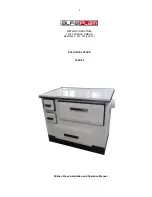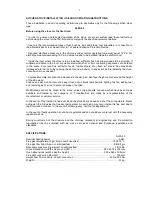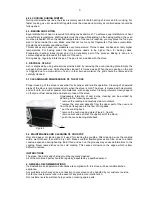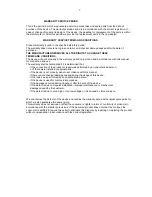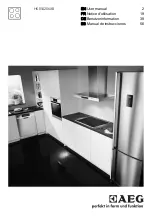
6
4.2.2
COOKING DURING WINTER
During cold weather periods, the stove is mainly used for both heating of rooms and for cooking. For
faster cooking, use dry wood. Draft regulator must be closed and primary air control damper should be
fully opened.
4.3. BAKING AND FRYING
Equal distribution of heat is required for baking cakes and meat. To achieve equal distribution of heat
and sufficient temperature, draft regulator must be closed. Depending on the baking method, the oven
must be preheated. When the desired temperature of the oven is reached, you may place the food you
want to bake inside the oven. Make sure that not too many hot fragments of fuel are accumulated.
Constantly add smaller quantities of fuel.
Thicker cakes are baked at a moderate oven temperature. Thinner cakes are baked at fairly higher
temperatures. For baking meat, the temperature needs to be higher than for baking cakes.
Preparation (heating) takes longer and it is a necessary part of the process. Baking is done in a
circular-shaped pan placed at the bottom of the oven.
During baking, regularly rotate the pan. The pan is not included with the stove.
5
.
DISPOSAL OF
ASH
Ash is disposed by using accessories provided and by removing the oven cleaning plate. Empty the
ash pan before each use. Grills should be cleaned 1-2 times a week. When the air opening on the grill
is clogged due to accumulation of ash or other burned material, the grill should be removed and
carefully cleaned.
5.1 CLEANING AND MAINTENANCE OF THE STOVE
Proper cleaning of the stove is essential for its proper and reliable operation. Cleaning of enameled
areas of the stove is recommended only when the stove is cold. The stove is cleaned with clear water
and soft cloth, and under special circumstances, with soapy water. Cleaning intervals mostly depend
on the type of fuel and period and manner of use of the stove.
Unnecessary formation of dust during cleaning can be avoided by
adhering to the following sequence:
* remove the cooktop and carefully clean it outdoors,
* remove the soot and deposits from the upper part of the oven and
from the parts exposed to the flow of hot gases,
* put the cooktop back,
* remove the oven cleaning plate (Figure 3, Item 9),
* remove soot and ash from the upper part of the stove,
* push the oven cleaning plate back.
Figure 3
5.2 MAINTENANCE AND CLEANING OF COOKTOP
Only sand paper or cleaning agent is used for cleaning the cooktop. After cleaning, wipe the cooktop
with a wet cloth and then with a dry cloth. Make sure that flexible grooves are free, so as to enable
cooktop expansion during heating. Burnt food and ash on the grooves may cause deformations to the
cooktop. Never leave dishes on the cold cooktop. This causes corrosion on the edges, which is later
difficult to remove.
INSTRUCTIONS
The stove, flue ducts and chimney must be regularly cleaned.
All of the mentioned parts should be regularly inspected by a qualified person.
6. GENERAL RECOMMENDATIONS
If all installation and operation instructions are complied with, this stove will be a reliable kitchen
appliance.
Any problems which may arise in connection to your stove can be handled by our customer service.
Contact our customer service in the event of any problems or malfunction.
Our customer service will also help you when ordering spare parts.
9

